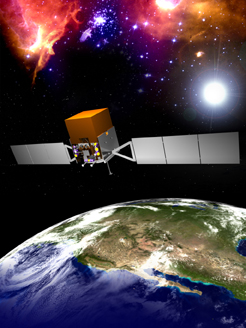Welcome to the LAT User Workbook.
New: Backup mailing lists in case Stanford or SLAC goes down. (See Alternate Mailing List.)

Trackers: Satellite Tracker and
Real Time Satellite Tracking
| NOTICE: To fully utilize this site, both Java and JavaScript functionality must be enabled on your browser. Also see Java Downloads for All Operating Systems for the latest version for your computer. |
Get Started --> Get Connected |
Mandatory Training - If you have a SLAC computing account, including Windows, Linux/Unix/Solaris or VMS account used to access SLAC information resources, you are required to take a computer security awareness course yearly. If this requirement is not met, your SLAC account(s) will be disabled. (See Cyber Security Awareness.) New users have 30 days in which to complete this course; however, it is recommended that you take it as soon as possible. |
Disk Space:
|
New to the collaboration? If you have recently joined the collaboration and are wondering how best to get started:
Refer to the red navigation bar above and:
1.) First take a look at some of the Fermi Links to familiarize yourself with our mission, history, basic concepts and terminology.
2.) Then click on the Get Started button.
Note: The buttons on the 2nd-level navigation bars are laid out from left to right to help guide you through the process of familiarization with our software, facilities, and software setup.
3.) The next three buttons on the red navigation bar (Science Tools, Science Analysis, and Data Access) connect you to the remaining three sections of the workbook that are intended for use by those of you who are primarily interested in performing Science Analysis.
Note: The remaining buttons (Instrument Analysis II, Advanced, and CMT Archive) are intended for those who are interested in developing ground software for the instrument itself, or in developing the actual ScienceTools provided to the collaboration; they are not intended for use by those performing science analysis and not interested in developing new software.
Tips:
- Getting Lost in Workbook World? Click on the skymap logo in the upper left of the banner; this will return you to this, the workbook's home page.
- Check out the glossary (see banner button). If you have terms or acronyms that should be added, email Chuck Patterson (and include the definition if you already have it handy).
- Try out the WB's search engine (see banner's search box).
- Traveling? Take the workbook with you: Download-08-00-09: ~330 MB zipped;
~ 405 MB unzipped.
- To bookmark a page, first right click on the link to that page and open it in a new tab.
- Be sure to bookmark the workbook's Mirror Site, but not on your SLAC browser (in case of a power outage).
- WB Change Log: See
LAT Workbook Change Log.
- Having problems accessing SLAC email using Outlook? Use the following URL:
- Recommended Reading: Exploring Nature's Highest Energy Processes with the Gamma-ray Large Area Space Telescope
Getting Lost in Confluence?
Caution! As the collaboration's wiki, confluence has proven to be a very popular and useful tool; however, its greatest strength is also, in some respects, its greatest weakness.
There is no one gatekeeper; any individual or group can create a new page or child page without having to check with anyone other than - perhaps - a group's leaders. This means that formats, structures, naming conventions, etc. can be created "on-the-fly", free of bureaucratic overhead.
But, it also means quickly getting lost in Confluence until you have mastered the basics and are working within a group.
Bottom line, Confluence is not the best place to grab hold of when you are first climbing aboard a moving freight train, a.k.a. the Fermi LAT Collaboration. Welcome aboard!
Security Issue(s):
SCP/WinSCP. Be sure to use SCP or WinSCP (which are based on the SSH protocol) to transfer computer files between a local and a remote host, or between two remote hosts. Do NOT use Authenticated FTP, which sends a clear-text account name and password.
As announced in the December 16, 2010 LAT Newsletter, we have set up backup mailing lists in case Stanford or SLAC goes down that cover the collab, alt-slac, opsprob and latops lists (the latter two are for operational issues). The backup mailing lists at LLR are all now online. These will be used if Stanford goes offline or, in case SLAC goes down, to communicate with those whose SLAC emails are their primary address. We'll announce when to start (and stop!) using the lists when the time comes.
Here are the list names:
| Stanford | LLR | |
|---|---|---|
| Collaboration List | collablist@glast.stanford.edu | fermi-collab-l@in2p3.fr |
| SLAC unix account holders | slacuser@glast.stanford.edu | |
| SLAC unix account holders secondary email | slacalt@glast.stanford.edu | fermi-altslac-l@in2p3.fr |
| problems notification | opsproblist@glast.stanford.edu | fermi-opsprob-l@in2p3.fr |
| LAT ops list | latopslist@glast.stanford.edu | fermi-latops-l@in2p3.fr |
| Please send us your comments on this workbook. Important! If referring to a specific page, please right click on the link to that page and open it in a new tab or window; then include that url in the text of your message.) | ||
workbook-08-00-09